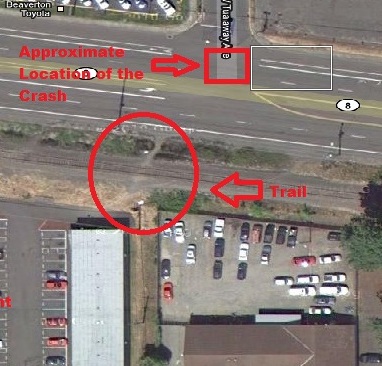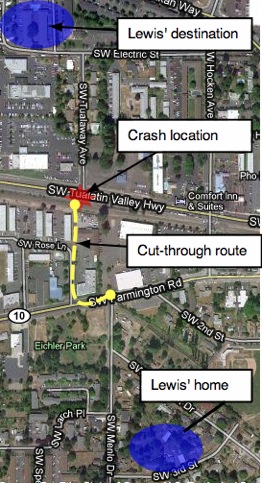New analysis of the crash that claimed the life of 47-year old Beaverton resident Bret Lewis last Saturday reveals that — contrary to what was reported initially by the Beaverton Police Department and subsequently covered by several local media outlets (including this one) — it’s very possible that Lewis was crossing Tualatin Valley (TV) Highway prior to being hit.
The police reported that Lewis was bicycling westbound on TV Hwy and that he was hit from behind by James Nguyen. Much of the discussion around this tragedy has revolved around why Lewis was not riding in the bike lane or the lane nearest to the curb (witnesses have helped police determine that Lewis was in the lane to the south of the bike lane).
But, what if Lewis was crossing the street? Would/should that change how we make sense of this tragedy?

We first began to consider the possibility that he was crossing (and not riding on) the highway when our West Side correspondent Jim Parsons shared the aerial photo above in which he points out a footpath leading onto TV Hwy that’s adjacent to the intersection where Lewis was hit (SW Tualaway Ave). After seeing Parson’s image, I learned through email conversations with Lewis’ close friends that he lived directly south of the intersection.

Lewis lived on SW 3rd St between Fairmount and Menlo. One of his friends shared with me that, “It’s likely he was trying to cross there to cut through to his home.” That same friend shared that, “There is nothing or no one in Bret’s life west of SW Tualaway.” Another friend of Lewis’ told me that, “He was on his way over to his friend’s apartment,” which she confirmed was north of Tualaway (see map).
If Lewis was crossing (and not riding westbound on) TV Hwy, it would also help explain why Mr Nguyen was unable to see him. Lewis had a functioning light on his bike, but Nguyen told police he couldn’t see it in time to avoid hitting him. If Lewis was crossing the street north to south, a light on the rear of his bicycle would not have been visible to someone in a motor vehicle headed west. As for why Lewis was stopped in the traffic lane prior to the collision, we’ll likely never know.
Does this fundamentally change this case? Yes. The legal context of both Lewis and Nguyen’s actions change if Lewis was crossing a street versus riding a bicycle with the flow of traffic. Would Oregon’s crosswalk law apply in this location? Would this intersection meet the legal definition of a crosswalk? I’m not sure, but perhaps someone else could chime in to clarify.
Editorial note: This story isn’t an attempt to find out who’s to blame in this tragedy. My intention in publishing this is to shed light on what seems like a very plausible scenario in hopes that it can help those in the community who are still trying to make sense of what happened. In addition, I feel this type of detail is yet another reason why police statements drafted immediately following a crash should refrain from drawing too many conclusions so as not to mislead the public about how a crash occurred before a thorough investigation has been done.

